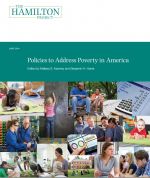
This proposal is chapter eleven of The Hamilton Project’s Policies to Address Poverty in America, and a segment in Improving Safety Net and Work Support.
Introduction
The Earned Income Tax Credit (EITC) provides a refundable tax credit to lower-income working families. In 2011, the EITC reached 27.9 million tax filers at a total cost of $62.9 billion. Almost 20 percent of tax filers receive the EITC, and the average credit amount is $2,254 (IRS 2013). After expansions to the EITC in the late 1980s through the late 1990s—under Democrat and Republican administrations—the EITC now occupies a central place in the U.S. safety net. Based on the Census Bureau’s 2012 Supplemental Poverty Measure (SPM), the EITC keeps 6.5 million people, including 3.3 million children, out of poverty (Center on Budget and Policy Priorities [CBPP] 2014a). No other tax or transfer program prevents more children from living a life of poverty, and only Social Security keeps more people above poverty.
Since the EITC is only eligible to tax filers who work, the credit’s impact on poverty takes place through encouraging employment by ensuring greater pay after taxes. The empirical research shows that the tax credit translates into sizable and robust increases in employment (Eissa and Liebman 1996; Meyer and Rosenbaum 2000, 2001). Thus, the credit reduces poverty through two channels: the actual credit, and increases in family earnings. This dual feature gives the EITC a unique place in the U.S. safety net; in contrast, many other programs redistribute income while, at least to some degree, discouraging work. Importantly, transferring income while encouraging work makes the EITC an efficient and cost-effective policy for increasing the after-tax income of low-earning Americans. Yet a program of this size and impact could be more equitable in its reach. Under the current design of the EITC, childless earners and families with only one child, for instance, receive disproportionately lower refunds.
In 2014, families with two children (three or more children) are eligible for a maximum credit of $5,460 ($6,143) compared to $3,305 for families with one child. Married couples, despite their larger family sizes, receive only modestly more-generous EITC benefits compared to single filers. Childless earners benefit little from the EITC, and have a maximum credit of only $496—less than 10 percent of the two-child credit.
Prominent proposals seek to mitigate these inequalities. President Obama’s fiscal year 2015 budget includes an expansion of the childless EITC, a concept outlined by John Karl Scholz in 2007 in a proposal for The Hamilton Project. Notably, MDRC is currently evaluating Paycheck Plus, a pilot program for an expanded EITC for workers without dependent children, for the New York City Center for Economic Opportunity (MDRC 2014). The recent Hamilton Project proposal for a secondary-earner tax credit addresses the so-called EITC penalty for married couples (Kearney and Turner 2013). And the more generous EITC credit for three or more children was recently enacted as part of the American Recovery and Reinvestment Act of 2009, and is currently scheduled to sunset in 2017.
Considering this broad set of EITC reforms, and recognizing the demonstrated effectiveness of the program as an antipoverty program with numerous benefits, this policy memo proposes an expansion for the largest group of EITC recipients: families with one child. In particular, I propose to expand the one-child schedule to be on par with the two-child schedule, in equivalence scale-adjusted terms. An equivalence scale captures the cost of living for a household of a given size (and demographic composition) relative to the cost of living for a reference household of a single adult, and is a standard component in defining poverty thresholds. The proposal expands the maximum credit for one-child families to $4,641, from $3,305 under current law, an increase of about 40 percent. The expansion will lead to a roughly $1,000 increase in after-tax income for taxpayers in the bottom 40 percent of the income distribution receiving the higher credit. As this paper outlines, the expansion is justified on equity and efficiency grounds. This expansion is anchored in the equity principle in that the generosity of the credit should be proportional to the needs of families of differing sizes; I use the equivalence scale implicit in the poverty thresholds of the Census SPM as a guide for household needs. This proposal is also supported by efficiency principles given the EITC’s demonstrated success at raising labor supply among single mothers.
The target population for the proposal is low-income working families with children. Implementing this proposal requires legislative action by the federal government; it is important to note that altering the EITC schedule requires a simple amendment to the tax code, and not a massive overhaul of our nation’s tax system. The revenue cost of the proposal derives from additional federal costs of the EITC, less the additional payroll and ordinary federal income taxes. The private benefits include increases in after-tax income and reductions in poverty. The proposal would also generate social benefits through the spillover effects that the increase in income plays in improving health and children’s cognitive skills (Dahl and Lochner 2012; Evans and Garthwaite 2014; Hoynes, Miller, and Simon forthcoming).



